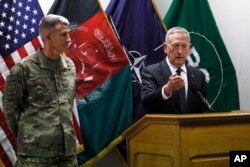The Taliban has unleashed its annual so-called “spring offensive” in Afghanistan, saying it will mainly target U.S.-led foreign “occupation” troops to force them to quit the country.
In a formal announcement released Friday, the Islamist insurgency claimed “Operation Mansouri” went into action early Friday morning across all 34 Afghan provinces.
It explained the offensive has been named after Taliban chief Mullah Akhtar Mansour, who was killed by an American drone last year.
“These operations will involve conventional attacks, guerrilla warfare, complex martyrdom (suicide) attacks, insider attacks, and use of IEDs (improvised explosive devices) to achieve their objectives,” said the statement by the Taliban’s so-called leadership war council.
Afghan Defense Ministry spokesman Mohammad Radmanesh dismissed the insurgent announcement as just another name terrorists are using for propaganda purposes and attacks against innocent civilians. He told VOA that Afghan forces are fully prepared and, as they did in the previous year, will defeat the Taliban’s so-called new “Operation Mansouri.”
No letup in attacks
While there has been no letup in insurgent attacks in Afghanistan over the past several years, the onset of springtime militants to ramp up their activities because melting snows on mountain peaks allows insurgents to launch major battlefield attacks.
Friday’s announcement came a week after the Taliban staged its deadliest raid on a major Afghan military base in the northern city of Mazar-i-Sharif.
The assault reportedly killed more than 250 Afghan soldiers and wounded many others. The casualty toll was much more than the losses Afghan forces suffered in the battlefield in the past several weeks, prompting the defense minister and the military chief to step down.
U.S. Defense Secretary Jim Mattis, during last week’s trip to Kabul, warned that 2017 will be a tough fighting year for Afghan security forces.
Analysts have warned that increasing contacts in recent months between Russia and the Taliban could complicate U.S.-led efforts to stabilize Afghanistan.
Commander of U.S. and foreign forces in the country, General John Nicholson, while speaking alongside Mattis, reiterated concerns over Russia’s involvement in the Afghan conflict and expressed Washington’s concern that Moscow is apparently sending weapons to the Taliban.
“We continue to get reports of this assistance, and, of course, we had the overt legitimacy lent to the Taliban by the Russians. That really occurred starting late last year, beginning through this process they’ve been undertaking,” asserted Nicholson.
Russian Foreign Minister Sergei Lavrov, while responding to the allegations earlier this week, dismissed them as “unprofessional and groundless assertions,” saying, “nobody has presented a shred of evidence to back them up.”
Lavrov reiterated that Moscow’s contacts with the Taliban are meant only to encourage insurgents to join peace and reconciliation talks with the Afghan government.
Civilians pay higher price
The Taliban has extended its territorial control in Afghanistan since the withdrawal of international combat troops in 2014 and inflicted heavy casualties on Afghan forces. Officials estimated that close to 7,000 Afghan security personnel were killed in 2016.
The intensification of fighting continues to also inflict high numbers of casualties on civilians, according to United Nations Assistance Mission in Afghanistan, or UNAMA.
The mission said Thursday 715 Afghan civilians died during the first quarter of 2017 while many more were wounded or maimed.
UNAMA documented a 54 percent increase in conflict-related deaths of women and a 17 percent rise in child fatalities compared to the same period last year.
“With the so-called fighting season imminent, I appeal to all parties to take every measure possible to prevent unnecessary and unacceptable harm to Afghan civilians,” said UNAMA chief, Tadamichi Yamamoto.











